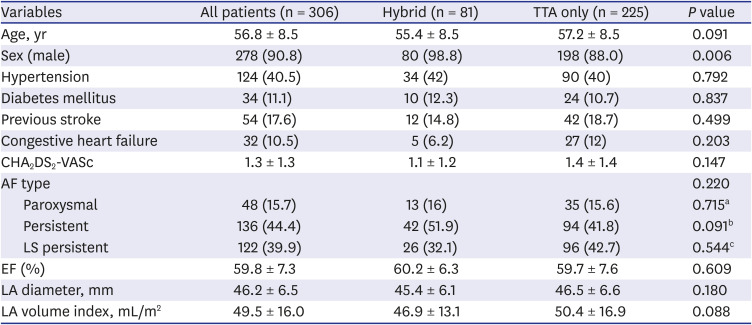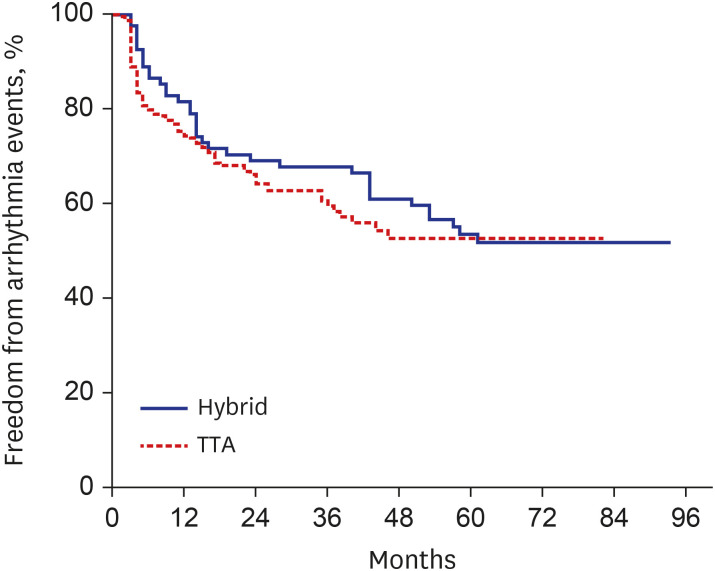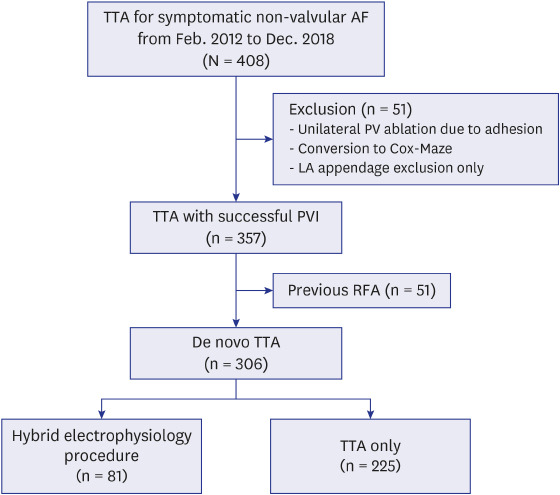1. Anter E, Jessup M, Callans DJ. Atrial fibrillation and heart failure: treatment considerations for a dual epidemic. Circulation. 2009; 119(18):2516–2525. PMID:
19433768.
2. Dries DL, Exner DV, Gersh BJ, Domanski MJ, Waclawiw MA, Stevenson LW. Atrial fibrillation is associated with an increased risk for mortality and heart failure progression in patients with asymptomatic and symptomatic left ventricular systolic dysfunction: a retrospective analysis of the SOLVD trials. J Am Coll Cardiol. 1998; 32(3):695–703. PMID:
9741514.

3. Haïssaguerre M, Jaïs P, Shah DC, Takahashi A, Hocini M, Quiniou G, et al. Spontaneous initiation of atrial fibrillation by ectopic beats originating in the pulmonary veins. N Engl J Med. 1998; 339(10):659–666. PMID:
9725923.

4. Marrouche NF, Brachmann J, Andresen D, Siebels J, Boersma L, Jordaens L, et al. Catheter ablation for atrial fibrillation with heart failure. N Engl J Med. 2018; 378(5):417–427. PMID:
29385358.

5. Verma A, Jiang CY, Betts TR, Chen J, Deisenhofer I, Mantovan R, et al. Approaches to catheter ablation for persistent atrial fibrillation. N Engl J Med. 2015; 372(19):1812–1822. PMID:
25946280.

6. Nery PB, Thornhill R, Nair GM, Pena E, Redpath CJ. Scar-based catheter ablation for persistent atrial fibrillation. Curr Opin Cardiol. 2017; 32(1):1–9. PMID:
27875475.

7. Suwalski P, Kowalewski M, Jasiński M, Staromłyński J, Zembala M, Widenka K, et al. Survival after surgical ablation for atrial fibrillation in mitral valve surgery: Analysis from the Polish National Registry of Cardiac Surgery Procedures (KROK). J Thorac Cardiovasc Surg. 2019; 157(3):1007–1018.e4. PMID:
30314688.
8. Gillinov AM, Gelijns AC, Parides MK, DeRose JJ Jr, Moskowitz AJ, Voisine P, et al. Surgical ablation of atrial fibrillation during mitral-valve surgery. N Engl J Med. 2015; 372(15):1399–1409. PMID:
25853744.

9. Pyo W, Park SJ, Kim WK, Kim HJ, Kim JB, Jung SH, et al. Surgical ablation of atrial fibrillation in patients undergoing bioprosthetic valve replacement. Korean J Thorac Cardiovasc Surg. 2019; 52(2):61–69. PMID:
31089442.

10. Hindricks G, Potpara T, Dagres N, Arbelo E, Bax JJ, Blomström-Lundqvist C, et al. 2020 ESC Guidelines for the diagnosis and management of atrial fibrillation developed in collaboration with the European Association for Cardio-Thoracic Surgery (EACTS): The Task Force for the diagnosis and management of atrial fibrillation of the European Society of Cardiology (ESC) Developed with the special contribution of the European Heart Rhythm Association (EHRA) of the ESC. Eur Heart J. 2021; 42(5):373–498. PMID:
32860505.
11. Phan K, Phan S, Thiagalingam A, Medi C, Yan TD. Thoracoscopic surgical ablation versus catheter ablation for atrial fibrillation. Eur J Cardiothorac Surg. 2016; 49(4):1044–1051. PMID:
26003961.

12. On YK, Park KM, Jeong DS, Park PW, Lee YT, Park SJ, et al. Electrophysiologic results after thoracoscopic ablation for chronic atrial fibrillation. Ann Thorac Surg. 2015; 100(5):1595–1602. PMID:
26215779.

13. Choi MS, On YK, Jeong DS, Park KM, Park SJ, Kim JS, et al. Usefulness of postprocedural electrophysiological confirmation upon totally thoracoscopic ablation in persistent atrial fibrillation. Am J Cardiol. 2020; 125(7):1054–1062. PMID:
31948665.

14. Wolf RK, Schneeberger EW, Osterday R, Miller D, Merrill W, Flege JB Jr, et al. Video-assisted bilateral pulmonary vein isolation and left atrial appendage exclusion for atrial fibrillation. J Thorac Cardiovasc Surg. 2005; 130(3):797–802. PMID:
16153931.

15. Jadidi AS, Cochet H, Shah AJ, Kim SJ, Duncan E, Miyazaki S, et al. Inverse relationship between fractionated electrograms and atrial fibrosis in persistent atrial fibrillation: combined magnetic resonance imaging and high-density mapping. J Am Coll Cardiol. 2013; 62(9):802–812. PMID:
23727084.
16. Nagashima K, Watanabe I, Okumura Y, Iso K, Takahashi K, Watanabe R, et al. High-voltage zones within the pulmonary vein antra: major determinants of acute pulmonary vein reconnections after atrial fibrillation ablation. J Interv Card Electrophysiol. 2017; 49(2):137–145. PMID:
28432503.








 PDF
PDF Citation
Citation Print
Print





 XML Download
XML Download